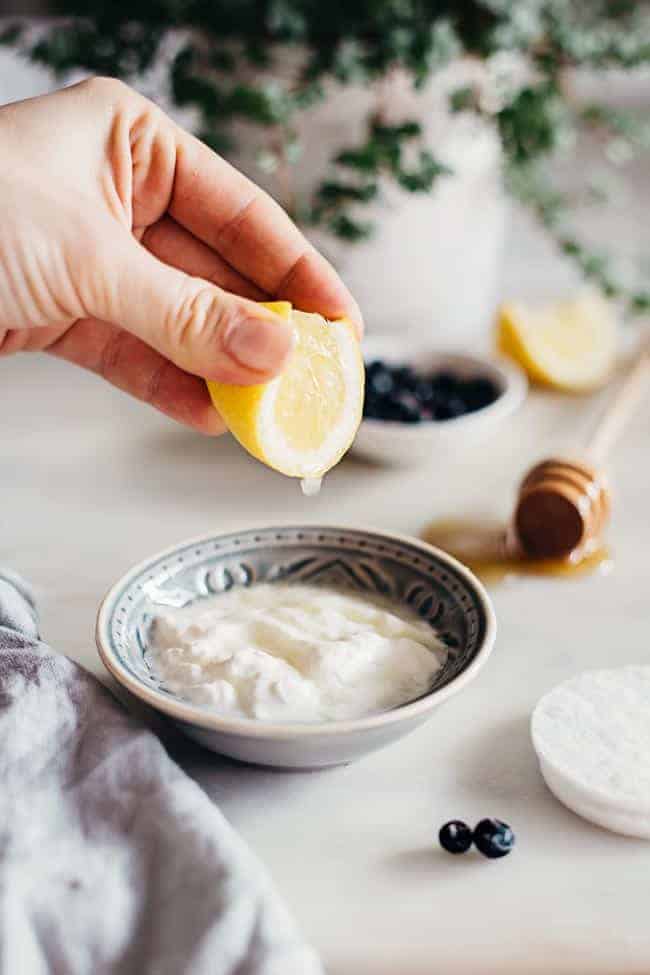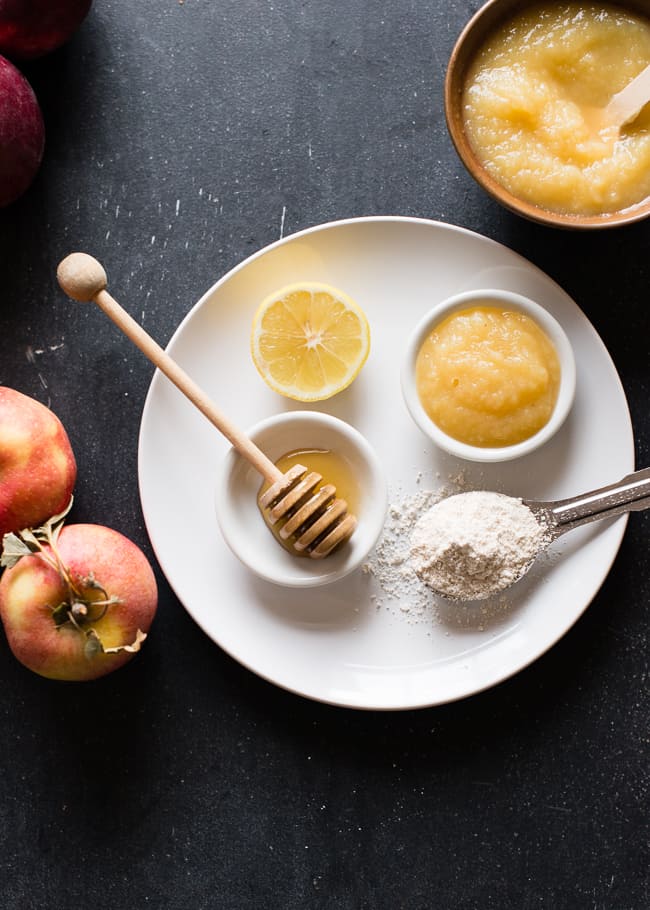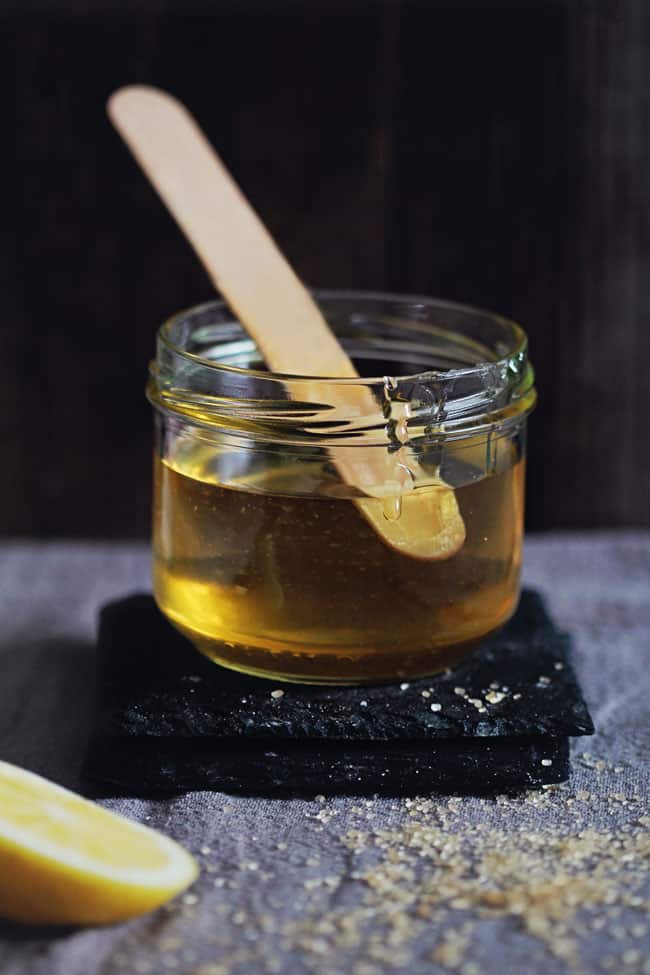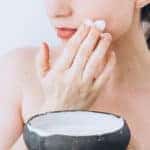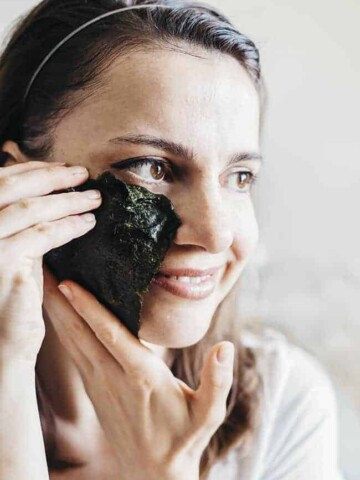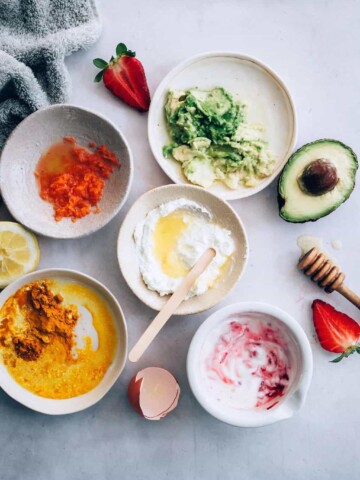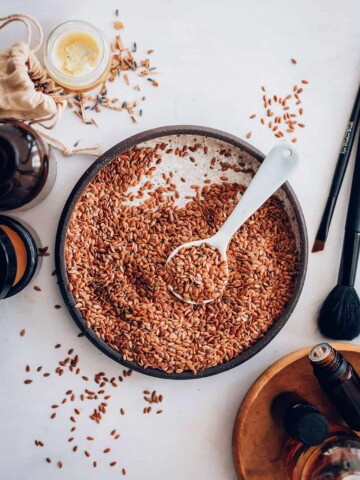Alpha hydroxy acids (AHAs) derived from fruit acids are among the best ways to exfoliate your skin. By breaking down the bonds that hold the cells together, they help slough off the dead skin cells, loosen dirt, makeup, and clogged pores to reveal smooth skin beneath [source].
There are several types of fruit acids found in commercial skincare products today [source], but they can also be easily made with a few fresh ingredients at home. When applied to the face, these simple AHA face masks help revitalize skin, giving you a gorgeous, fresh glow.
Just be sure you are following any fruit acid treatment or mask with the proper sunscreen. The last thing you’ll want to do is subject those new skin cells to sun damage because that contributes to aging, the opposite of what we are trying to achieve!
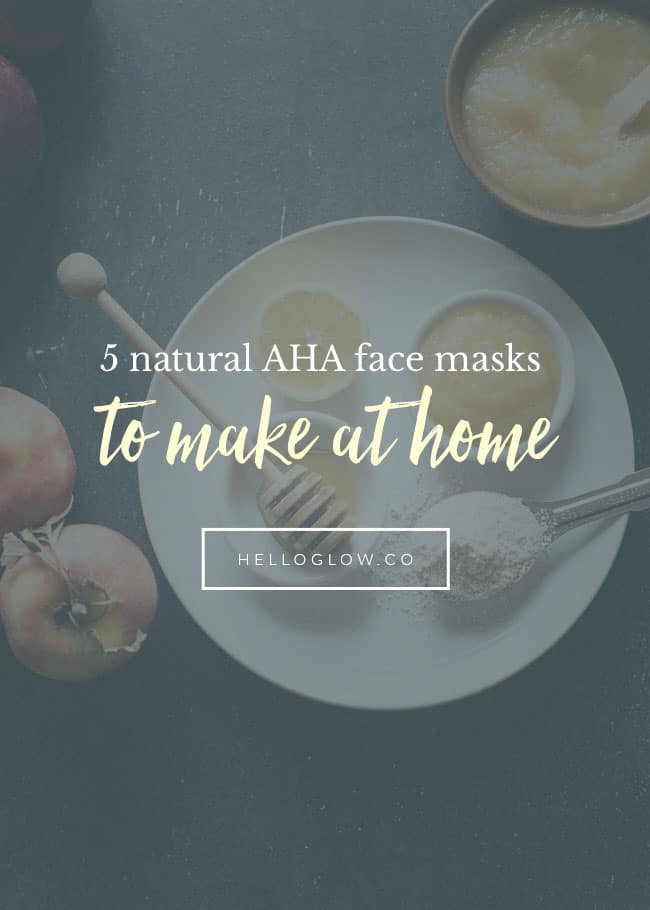
5 AHA Face Mask Recipes
1. Lactic Acid
One of the more gentle fruit acids, lactic acid, is ideal for sensitive skin and fighting acne. Known to have moisturizing properties, it is also acid-balancing and filled with probiotics [source]!
This natural acid is commonly found in dairy products like yogurt and some fruits, such as grapefruit, and can be applied weekly for optimal benefits. Lactic acid is a great introduction to the alpha hydroxy acids and can be a good test of your sensitivity to fruit acids, in general.
Yogurt and Grapefruit Mask
- ½ grapefruit, juiced
- ½ cup plain, unsweetened organic yogurt
Mix yogurt with the juice from ½ grapefruit in a bowl. Apply a thin layer to clean skin, and leave it on for 10 minutes. Rinse with warm water and follow with your daily moisturizer. Apply weekly as a face mask.
(Vegans can replace the yogurt with a couple of tablespoons of powdered clay, or check out the alternatives in recipe #2 or #4.)
2. Tartaric Acid
Tartaric acid is naturally found in grapes and bananas, and when applied topically, it can smooth the skin, enhancing your skin’s natural glow. Champagne (fermented grape juice) is an easily available source of tartaric acid, which makes this detoxifying face mask a great choice for a light alpha-hydroxy treatment.
Or give this second recipe for an anti-aging wine mask a shot for a gentle dose of tartaric acid.
Detoxifying AHA Mask with Champagne
- ¼ cup champagne
- 4 ounces powdered clay (Bentonite is a great choice for all skin types.)
- 2 tablespoons organic heavy cream, half and half, or plain, unsweetened yogurt (vegans mix with water or raw organic apple cider vinegar in the same quantity)
Spoon the clay into a mixing bowl, then slowly pour in the cream or yogurt, gently stirring as you pour. Add the champagne and mix again.
Apply to your face and neck and let sit for about 20 minutes. Rinse with warm water and a washcloth, then follow with your daily skincare routine.
Anti-Aging Wine Mask
- 2 tablespoons red or white wine
- Handful of organic red grapes
- 1 tablespoon bentonite clay
- 1 teaspoon raw honey
Combine all ingredients in a non-metal bowl. Squeeze or crush a few of the grapes to extract the fresh juice. Mix until you have a smooth consistency, adding more wine if needed.
Spread the paste evenly over a clean face and neck, avoiding the eye area. Relax and let the mask penetrate for 10–15 minutes. Rinse and follow with moisturizer.
3. Citric Acid
Citric acid can be found in various citrus fruits such as oranges, lemons, grapefruit, and limes. It has many benefits for the skin, but as far as AHA face masks go, citric acid is best known for lightening acne spots and improving the overall texture of skin. This homemade lemon and milk facial mask can help inject some citric acid into your beauty routine.
While you can use most citrus fruits, it's best to avoid limes, as exposure to sunlight 48 hours after lime juice touches your skin can set up some predisposed people to a nasty case of dermatitis.
Lemon + Milk Mask
- 2 tablespoons full-fat organic milk
- 1 tablespoon fresh lemon juice
Mix milk with lemon juice in a small bowl, and let it sit on the counter for a couple of hours until it curdles. Then apply liberally to your neck and face, avoiding the eyes. Leave on for at least 20 minutes (longer is okay), and you’ll feel it tightening as it dries. Then rinse with warm water and apply moisturizer.
4. Malic Acid
Malic acid is found most abundantly in apples. It can reduce signs of aging, help alleviate acne, brighten skin tone, and promote collagen production. Serving as a humectant, malic acid also retains moisture. You can enjoy the benefits of malic acid with this apple cider vinegar peel.
Apple Cider Vinegar Peel (a good one for vegans)
- 1 tablespoon organic, raw, unfiltered organic apple cider vinegar
- ½ lemon, juiced (optional, and those with sensitive skin should skip it)
In a bowl or small cup, combine apple cider vinegar and lemon juice (if using). Using a cotton round, dip it in the apple cider vinegar and gently swab over your face in circular motions, steering clear of the eye area.
Tingling sensations are to be expected. However, if you feel burning, you can dilute the apple cider vinegar with some water. If the tingling or burning sensation does not subside with cooling and frequent skin moisturization, it is recommended that you contact your dermatologist.
5. Glycolic Acid
Glycolic acid is one of the most popular rapid exfoliators available, making it a frequent additive in most anti-aging products. It’s derived from sugar cane and has shown tremendous success regenerating the surface layers of the skin and lessening the appearance of superficial scars and hyperpigmentation [source].
Using a few ingredients from your pantry, you can get the benefits of glycolic acid with the help of this AHA sugar mask.
Honey + Sugar AHA Face Mask
You’ll want the sugar to be as fine as possible (but not processed to fine like white sugar), so you’ll probably want to use a coffee grinder or blender to break it down. Then combine the sugar and honey in a bowl. Squeeze the juice of half a lemon into the bowl and mix well.
Apply the mixture to your face and neck, avoiding the eye area. Rinse with warm water after 5–10 minutes. In the beginning, start with just 1–2 minutes and gradually increase the time with each application to a maximum of 10 minutes.
Glycolic acid use should be gradually increased, so limit the length of time on your skin in the beginning, or extend the frequency of application if you find your skin becomes sensitive to its effects.
Many people with sensitive-skin or rosacea-prone skin can have a bad reaction to glycolic acid, so avoid it altogether if you fall into this group.
AHA Face Mask FAQs
Can I add apple cider vinegar (malic acid) to the glycolic acid mask, or would that be overkill?
Sure, however, it’s best to be careful and go slow. Adding more acid to a mask may increase irritation, especially if you have sensitive skin. I recommend adding 1 teaspoon of apple cider vinegar and testing it on your wrist before applying to your face.
Does sugar really contain glycolic acid?
Raw sugarcane does contain glycolic acid [source] [source], which is why we recommend using sucanat or turbinado sugar in our Honey + Sugar AHA Face Mask (the lemon has AHAs, too). While you can use white sugar, since it’s highly processed, you’re bound to get less glycolic acid and thus less of an effect than with raw sugar.
How strong are these masks? Can they be done multiple times a week?
While natural ingredients like lemon juice and apple cider vinegar are pretty strong, they’re not as potent as what you’d get at the dermatologist’s office. I recommend using them 1–2 times a week at most. Any more, and you run the risk of over-exfoliating your skin, which can do more harm than good in the long run.
As always, listen to your skin, give it time to rest between treatments, and always, always wear sunscreen when spending time outside.
Why do I need to avoid the eye area with these masks?
For starters, the eye area is more delicate than other areas of the face, and applying acid can cause redness and irritation. Second, these masks have a tendency to tingle or sting, which can be pretty irritating and even do serious damage to your eyes.
Can you exfoliate (with a sugar scrub, for example) before using one of these masks?
Since AHAs naturally exfoliate skin, using a scrub prior to applying to an AHA face mask may be too harsh. Not only does it increase the likelihood of pain and irritation, but it can also break down your skin's moisture barrier, making skin look and feel more irritated and splotchy than before.
5 AHA Face Masks You Can Make at Home
Equipment
- Small bowl
Materials
Yogurt and Grapefruit Mask
- ½ grapefruit juiced
- ½ cup plain organic yogurt
Detoxifying AHA Mask with Champagne
- ¼ cup champagne
- 4 ounces powdered healing clay (Bentonite clay is a great choice for all skin types.)
- 2 tablespoons organic heavy cream, half and half, or plain, unsweetened yogurt
Anti-Aging Wine Mask
- 2 tablespoons red or white wine
- Handful of organic red grapes
- 1 tablespoon Bentonite clay
- 1 teaspoon raw honey
Lemon + Milk Mask
- 2 tablespoons organic full fat milk
- 1 tablespoon fresh lemon juice
Apple Cider Vinegar Peel
- 1 tablespoon organic raw, unfiltered apple cider vinegar
- ½ lemon juiced (optional, however those with sensitive skin should skip the the lemon)
Honey + Sugar AHA Face Mask
- 2 tablespoons raw organic sugar
- 2 tablespoons raw honey
- Juice of ½ lemon
Instructions
Yogurt and Grapefruit Mask
- Mix yogurt with the juice from ½ grapefruit in a bowl. Apply a thin layer to clean skin and leave on for 10 minutes. Rinse with warm water and follow with daily moisturizer. Apply weekly as a face mask.
Detoxifying AHA Mask with Champagne
- Spoon the clay into a mixing bowl, then slowly pour in the cream, gently stirring as you pour. Add in the champagne, and mix again.
- Apply to face and neck and let sit for about 20 minutes. Rinse with warm water and a washcloth, then follow with your daily skincare routine.
Anti-Aging Wine Mask
- Combine all ingredients in a non-metal bowl. Squeeze or crush a few of the grapes to extract the fresh juice. Mix until you have a smooth consistency, adding more wine if needed.
- Spread the paste evenly on to a clean face and neck, avoiding the eye area. Relax and let the mask penetrate for 10–15 minutes. Rinse and follow with moisturizer.
Lemon + Milk Mask
- Mix milk with lemon juice in a small bowl, then let the mixture sit on the counter for a couple of hours until it curdles. Apply liberally to neck and face, avoiding the eyes. Leave on for at least 20 minutes (longer is okay), and you’ll feel it tightening as it dries. Then rinse with warm water and apply moisturizer.
Apple Cider Vinegar Peel
- In a bowl or small cup, combine apple cider vinegar and lemon juice (if using). Using a cotton round, dip it in the apple cider vinegar, and then gently swab over face in circular motions. Avoid the eye area.
- Tingling sensations are to be expected. However, if you feel burning, you can dilute the apple cider vinegar with water. If the tingling and/or burning sensation does not subside with cooling and frequent skin moisturization, it is recommended that you contact your dermatologist.
Honey + Sugar AHA Face Mask
- You’ll want the sugar to be as fine as possible, so if it’s coarse you’ll want to use a coffee grinder or blender to break it down. Then combine the sugar and honey in a bowl. Squeeze the juice of half a lemon and mix well.
- Apply to the face and neck, avoiding the eye area. Rinse with warm water after 5–10 minutes. In the beginning, start with just 1–2 minutes and gradually increase time to a maximum of 10 minutes.
Notes
References:
1. Kornhauser A, et al. Applications of hydroxy acids: classification, mechanisms, and photoactivity. Clin Cosmet Investig Dermatol. 2010.
2. Tran D, et al. An antiaging skin care system containing alpha hydroxy acids and vitamins improves the biomechanical parameters of facial skin. Clin Cosmet Investig Dermatol. 2015.
3. Tang SC, et al. Dual effects of alpha-hydroxy acids on the skin. Molecules. 2018.
4. Sharad J. Glycolic acid peel therapy—a current review. Clin Cosmet Investig Dermatol. 2013.
5. Lachaux C, et al. A new synthetic pathway for the bioproduction of glycolic acid from lignocellulosic sugars aimed at maximal carbon conservation. Front. Bioeng. Biotechnol. 2019.
This post was medically reviewed by Dr. Jennifer Haley, a board-certified dermatologist with extensive experience in medical, cosmetic, and surgical dermatology. Learn more about Hello Glow’s medical review board here. As always, this is not personal medical advice, and we recommend that you talk with your doctor.
586

